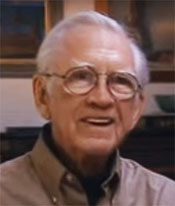 Alexander Hume Anderson Jr. was a pioneer in television animation. He developed Crusader Rabbit, the first made-for-TV cartoon. In the fall of 1948, NBC agreed to carry the show. Then, only months later, they turned it down. The network’s independent entertainment content provider, Jerry Fairbanks, decided to distribute it himself, selling it to stations across the U.S.A.
Alexander Hume Anderson Jr. was a pioneer in television animation. He developed Crusader Rabbit, the first made-for-TV cartoon. In the fall of 1948, NBC agreed to carry the show. Then, only months later, they turned it down. The network’s independent entertainment content provider, Jerry Fairbanks, decided to distribute it himself, selling it to stations across the U.S.A.
Anderson, who also created Rocky, Bullwinkle, and Dudley Do-Right, saw a pathway to making a cartoon for television after seeing an animation demonstration in the 1941 Disney filmn.The Reluctant Dragon The piece showed how even “limited animation” could still tell a story and be visually compelling.
That was the challenge. There was no way theatrical animation standards could be applied to made-for-TV cartoons. The revenue from a show would never cover the expense. It also had to be drawn differently, as well.
 Alex Anderson imagined “limited animation,” a process that was less fluent, manipulated cut-out art elements, and that utilized motion of the camera, was the answer. Fewer drawings, close-ups, and characters reacting to action instead of fully depicting it. It made sense to him.
Alex Anderson imagined “limited animation,” a process that was less fluent, manipulated cut-out art elements, and that utilized motion of the camera, was the answer. Fewer drawings, close-ups, and characters reacting to action instead of fully depicting it. It made sense to him.
But it wasn’t going to happen at Terrytoons, where he worked. Not just yet, anyway.
Anderson was employed by his uncle, Paul Terry, founder of the company, when he first tinkered with a cartoon series for TV. Anderson approached Terry about it, but he wouldn’t touch it. 20th Century Fox, who distributed Terrytoons cartoons, saw the emerging field of TV as the enemy. They would drop Terrytoons if it got anywhere near creating content for the boob tube.

The TAP staff in 1948
The character Crusader Rabbit originated back at Terrytoons. Anderson came up with an idea for a TV series starring a donkey. He brought his concept to Arthur Bartsch, who suggested nixing the jackass for a rabbit.
Subsequent influences occurred after TAP was established. Jay Ward suggested the title, Crusader Rabbit, giving the hare a name. Gerald Ray refined the rabbit’s appearance for the actual series.
The first series, completed in 1951, featured 195 black and white chapters, parsed into 10 adventures. With no further orders coming in, TAP closed its’ doors and Anderson and Ward found work elsewhere.
The second series, produced by Shull Bonsall’s TV Spots, included 260 chapters, all shot in color, parsed into 13 adventures.
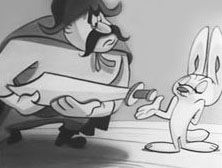 Bonsall, a businessman and scavenger, loved to make money off the misfortunes of others. When Fairbanks couldn’t pay back loans he had taken out with NBC to make Crusader Rabbit, NBC sued and took all 195 films. They sold them through Consolidated Television Sales. Bonsall bought Consolidated in February 1954, acquiring all of the films. Bonsall then purchased TV Spots (animation studio) in the summer of 1955. Then Bonsall began entertaining the notion of producing a Crusader Rabbit series.
Bonsall, a businessman and scavenger, loved to make money off the misfortunes of others. When Fairbanks couldn’t pay back loans he had taken out with NBC to make Crusader Rabbit, NBC sued and took all 195 films. They sold them through Consolidated Television Sales. Bonsall bought Consolidated in February 1954, acquiring all of the films. Bonsall then purchased TV Spots (animation studio) in the summer of 1955. Then Bonsall began entertaining the notion of producing a Crusader Rabbit series.
Jay Ward was doing the same thing at the time. His friends, Leonard Key and Michael Lah, had encouraged him to bring back Crusader Rabbit. This led to the establishment of Shield Productions. Shield, founded by William Hanna and Lah, produced 11 new Crusader reels before a court action initiated by Bonsall scrapped the entire venture.
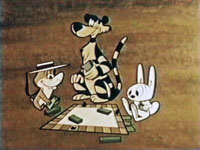
From the second series
The question was, who owned the rights to the character? Anderson did, with Ward, and settled the matter by selling Bonsall Television Arts productions. In May 1956, “Ramlen Associates” took over the exclusive rights to Crusader. Ramlen being Bonsall. He owned that company, too.
Leonard Key, who had encouraged Jay Ward to bring back Crusader, was now working for Bonsall, appointed as Ramlen president in December 1956. Key departed in April 1957 after TV Spots came under attack.
TV Spots was shut down in January 3, 1957 by striking members of the Screen Cartoonists Guild after complaints to the National Labor Relations Board. The Screen Actors Guild picketed outside TV Spots, next, on behalf of Lucille Bliss. Bonsall had offered Bliss less than union scale to reprise her role as the voice of Crusader Rabbit.
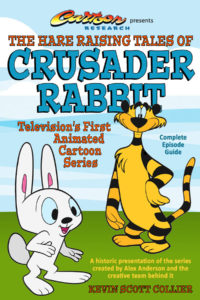 Most everything prior to the fall of 1957 regarding the Bonsall Crusader Rabbit series was hype. Stories had been written, but a full, competent staff wasn’t installed until then. The new series saw release in early summer, 1958.
Most everything prior to the fall of 1957 regarding the Bonsall Crusader Rabbit series was hype. Stories had been written, but a full, competent staff wasn’t installed until then. The new series saw release in early summer, 1958.
Crusader Rabbit’s return was quickly overshadowed by Jay Ward’s studio productions, and Hanna Barbera’s new, and upcoming, offerings. Regardless, Bonsall made a fortune on Crusader Rabbit, But, he lost it all during the production of Calvin and the Colonel a few years later.
My new “Cartoon Research” book The Hare Raising Tales of Crusader Rabbit details the Shull Bonsall fiasco, but it is mainly a tribute to Crusader Rabbit creator, Alex Anderson. Anderson was ahead of his time, and his legacy has been restored, especially after action against the Ward estate decades ago, where he regained the credit for creating Rocky, Bullwinkle and Dudley Do-Right.
Now that Disney owns the rights, it would be nice to see the original series, from 35mm film, brought back in DVD/blu-ray format. All that is commercially available for public purchase today is a three-disc collection that made use of old VHS tapes to comprise an incomplete collection.
Here it is – adventure #1, episode #1, of Crusader’s first cartoon, “Crusader Rabbit vs. the State of Texas”:











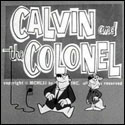





























I’d really love for the complete series to be released on DVD/BD as well.
Crusader Rabbit was one of the first things that got me glued to the TV after we got it in the fall of 1952; I was six. Did that start my lifelong love for animated cartoons? Who knows? Anyway, naturally I just now ordered the book.
Correction: Disney WILL own it upon the completion of their buyout of FOX.
I’m going to be honest on the original Crusader Rabbit series: I didn’t like it in the slightest. However, I do think the characters should get another chance.
I wish that someone like Shout! Factory or Thunderbean Animation would license Crusader Rabbit on DVD and Blu-Ray
I added the book to the Wikipedia entries for Crusader Rabbit and Alex Anderson.
I covered the history of Crusader Rabbit in more detail in two articles for Comics Scene in 1982 and 1983, “2 ½ Carrots Tall: TV’s First Animated Cartoon Star. Part 1, The Story Behind Crusader Rabbit” in Comics Scene #6, November 1982, pages 50-56, and “Part 2, The Stories of Crusader Rabbit” in Comics Scene #7, February 1983, pages 20-22. Except that Comics Scene edited out a lot of it because “nobody will be interested in so much detail”. I put some of what got cut out in “Some Notes on Crusader Rabbit” in the UCLA Animation Workshop’s “Animatrix” #6, Summer 1992, pages 29-36. I repeated this in one of my first Funny Animals and More columns for Cartoon Research, on April 28th, 2013.
I owed most of my research to Jerry Fairbanks. I interviewed him during earlier 1982. He said approximately, “That was more than thirty years ago, and I don’t remember much about it. But I kept clippings about all of it, and you can look through my scrapbooks.” He had EVERYTHING documented in his press releases and the articles in the trades based on them! When NBC sent Jay Ward on behalf of TAP to him in 1948. Their production of the first three episodes in 1949, and Fairbanks’ advertising of the show as if all 145 episodes were completed, during 1949 and early 1950. Contrary to Wikipedia, the first actual sale was to Los Angeles’ KNBH in 1950. TAP and Fairbanks hurried to get episodes #4 through #145 finished, and it went on the air beginning in August 1, 1950, not 1949. NBC authorized payment for #146 through #195 during 1951.
Contrary to both Wikipedia and what it says here, Cru and Rags never had a single villain in TAP’s and Fairbanks’ episodes. That was what Shull Bonsall advertised later. TAP created different villains for each “crusade” – Frank Sawbuck, Black Bilge, Dudley Nightshade, Babyface Barracuda, Gaston Glub, mad scientist Dr. Belfry Q. Batts, and so on. One of them was Whetstone Whiplash, and his hulking stooge, Bilious Greene. Both Dudley Nightshade and Whetstone Whiplash were designed after the 19th-century melodrama villains; lean, dressed in black, and twirling thin moustaches. By the time Shull Bonsall took over Crusader Rabbit, Bob Clampett’s Time for Beany was a hit with its recurring villain Dishonest John, also based on the melodrama villain image. So Bonsall claimed that all of Crusader Rabbit’s TAP villains had been Dudley Nightshade in disguise – taking advantage of the fact that nobody was showing the 195 black-&-white episodes any longer, and nobody remembered that the other villains hadn’t looked anything like Nightshade or Whiplash — and he made him the villain (using TAP’s design for Whiplash, not Nightshade) from then on.
I fixed the Wikipedia entry, adding the articles for further reading. Glad to share!
Was there ever an episode were he turned into a rocket fist kind of, to the tune of Bach or Beethoven symphony song? Mark 815-219-9999
There’s limited animation, and then there’s the earliest Crusader Rabbit episodes! This first one makes Colonel Bleep look hyperactive.
They must have been desperate to scrimp as much as possible at the start. Luckily they were able to strike a happy medium later – no need to resort to things like having the radio announcer hide his mouth behind a script to save on animation.
I haven’t seen Jerry Fairbanks’ scrapbooks for 35 years, but I still remember one of his press releases from January or February 1949, when he was just starting to promote the Crusader Rabbit series, that claimed that it was being made in a dynamic new animation process called Teletoon that was just as good as theatrical animation for a fraction of the cost. Nobody picked up on that, and it went on to become known as “limited animation”. Bob Givens, one of the TAP animators, said when I interviewed him, “We just called it ‘cheap animation’.”
This must have been the first use of Teletoon, which was later used in Canada as the name of a television channel for children’s animated programming.
Dana Gabbard, thanks for adding me to the Wikipedia article on “Crusader Rabbit”.
I certainly hope that Jerry Fairbanks’ scrapbooks went to some university library after his death. He had a huge bookcase of them. The scrapbooks covering “Crusader Rabbit” were only a fraction of them.
Ah, memories! I interviewed everyone who had ever worked on “Crusader Rabbit” for my articles in “Comics Scene” in 1982, except for Jay Ward. He refused to be interviewed.
My statement that the 1949-1951 TAP episodes never reused any villains wasn’t quite true. Alex Anderson said that after TAP had completed eight “crusades”, everyone re-assessed the series. They decided to redesign Cru and Rags to make them cuter and easier to draw. Most of the whiskers on Cru’s muzzle were dropped. They decided the series needed more continuing characters, so Cru’s & Rags’ pal Garfield Groundhog was added, and they would bring back their past villains instead of creating new ones for each crusade. They only got to reuse Dudley Nightshade in “Crusader and the Leprechauns” and Whetstone Whiplash & Bilious Greene in “Crusader and the Showboat” before NBC cancelled their funding.
Alex Anderson said that he had been specifically inspired to create limited animation for television by remembering the Baby Weems sequence in Disney’s “The Reluctant Dragon”. That hadn’t had any animation in it; just flash-focusing on a series of storyboards. But it had told a complete and amusing story.
When I interviewed Lucille Bliss, she said that Shull Bonsall’s offer for her to reprise Cru’s voice for his new episodes was so low — so much below union scale — that she had felt insulted. She refused, and Bonsall had gotten GeGe Pearson instead. (I never interviewed Pearson; I think she had died.) Bliss said, “I complained to the voice actors’ union, and we picketed Bonsall’s TV Spots for several weeks. Bonsall will deny it; he’s such a liar.” But when I interviewed Bonsall — he had given up TV and was a ranch foreman in Chatsworth by then — he said, “Yeah, the b—- called the union on us and they picketed us for several weeks! We didn’t let ’em stop us, though.”
Bonsall said that he had made a fortune on “Crusader Rabbit”. But he had decided to create a new series after it just when the mega-popular “Amos ‘n’ Andy” was forced off the air because of its old-fashioned stereotypes of “funny low-class Negroes”. Bonsall had the idea that Freeman Gosden and Charles Corell, the creators and main voices on radio of the series, were now at loose ends; and he could use their famous voices in an entirely new series. But Gosden & Corell had refused to work for him unless he gave them complete creative control over the new series. He had been forced to agree, and they had created “Calvin and the Colonel” which was blatantly just “Amos ‘n’ Andy” with funny animals. They even reused some of their old scripts with just the names changed. “Calvin and the Colonel” got all the racial protests that “Amos ‘n’ Andy” had by then, and Bonsall lost everything.
(Full disclosure: My father was a regular listener to “Amos ‘n’ Andy” on the radio during my childhood, and it was one of my favorite programs. I still remember the episode where Andy won a new radio in a contest, and the Kingfish tried to swindle him out of it. “Don’ ya know that if ya lissens ta too much radio, ya gets RADIO-ACTIVE?!” Yeah, well, it was funny in the late ‘40s. If you weren’t African-American.)
It would be interesting to see both the TV Spots reboot, assuming prints of it still exist, and, if so, are likely stored somewhere in a library at UCLA or CalArts or in the private collection of a film or animation archivist, and, in particular, the Shield Productions version, if any of those exist at all, provided the subsequent court order didn’t stipulate the destruction of all the completed episodes.
Crusader Rabbit almost makes Clutch Cargo look fully poseable. Yikes.
Was CR ever shown with a horse and armor as in the opening shots of the series? And if any of you ever comes across a CR cookie jar, let me know. It seems there was one in the past that was either commercially available, or was perhaps a custom made single issue. Any of you ever see one?
Yes I did see a Crusader Rabbit on his tournament dressed horse cookie jar back in 1964 at Marshall Fields store downtown Chicago. I wanted to buy it for my trousseau, but was refused by my parents. I’ve looked for one ever since. The glaze coloring was like crayon scribbles, not smooth color. A cookie jar was not on my Mom’s list of required household goods. Long live the rabbit!
Is the second Crusader Rabbit series available?
The Great Uranium Hunt” (also known as “Mine Your Own Business”)
“The Yukon Adventure” (also known as “Thar’s Gold in Them Fills”)
“Tales of Schmerwood Forest” (also known as “Crook’s Tour”)
“West We Forget”
“Sahara You”
“Gullible’s Travels”
“Should Auld Acquaintance Be for Cotton” (also known as “Belly Acres Mystery”)
“Nothing Atoll”
“Scars and Stripes”
“Apes of Rath”
“Caesar’s Salad” (also known as “There’s No Place Like Rome”)
“The Great Baseball Mystery” (also known as “Gone With the Wind-Up”)
“The Search for the Missing Link”
Only thru private collector and seller are the later 1957 color”Crusader Rabbit”TV Cartoons available..Frank..I’m sorry I wished that I could be of more help to you.
I have been trying to locate information about the Crusader Rabbit Stuffed Toy. Any ideas?